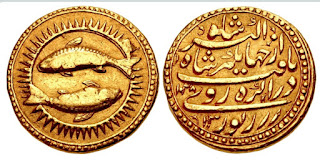Jahangir (31 August 1569 - 28 October 1627) was the fourth Mughal Emperor, of India who ruled from 1605 until his death in 1627. He was Akbar's son and succeeded to the throne on 3 November 1605, eight days after his father's death.
Jahangir, Mohur, 1605-1627, gold, SagittariusJahangir's coins are known for several innovations including the portrait Mughal Mohurs and the famous Zodiac series of coins.
The origin of Jahangir's zodiac series of coins is known from his own entry in his memoir ''Tuzk-e-Jahangir''. He wrote ''Previously to this, the rule of the coinage was that on the face of the metal they stamped my name, and on the reverse the name of the place and the year of the reign. At this time, it entered my mind that in place of the month they should substitute the figure of the constellation which belong to that month, in each month that was struck, the figure of the constellation was to be on one face, as if the sun was emerging from it''.
India in 1605 AD
Jahangir struck his zodiacal coins in gold and silver. The gold coins are known in all the 12 signs of the year, while those in silver were struck for the first five months. The first was in Farwardin, when the sun was in Aries, the second in Ardibihisht which corresponds to Taurus, the third in Khurdad with Gemini, the fourth in Tir with Cancer and the fifth in Amardan with Leo.
Jahangir's thirteenth regnal year began on the first day of Farwadin, when the sun entered Aries, but it was not until the twenty third day of that month that he decreed that the zodiacal coins were to be struck. He then made his state entry into the town of Ahmadabad, the capital of present day Gujarat, in the second month Ardibihisht, when the sun had been in Taurus for seven days, and he left in the fifth month, Amardan, when the sun was in Leo. The silver zodiacal coins were only struck just before and during Jahangir's visit to Ahmadabad, After that their minting stopped.
Mughal miniature from early 1620s depicting Jahangir. The Persian inscription '' though outwardly shahs stand before him, he fixes his gaze on dervishes''
However, his son Shah Jahan strongly disapproved of his father's zodiacal coins. After leaving Ahmadabad Jahangir stopped in Fatehpur as plague had broken out in Agra and this was where his first gold-zodiacal coin was struck in the month of Bahman with the sun sign Pisces. From then on Zodiac gold Mohurs were issued at Jahangir's pleasure, mostly from the mint at Agra. The last one being struck in his 22nd regnal year. This rupee bears the sign of Cancer, a crab on the reverse.
These presentation coins continued to be struck for the Mughal emperors until the dissolution of the Mughal Empire. However, the initial issues used in the Mughal court differ from the later strikes.
As Jahangir's successor Shah Jahan recalled all these coins and melted them, both original strikes and those struck later are very rare now.
Numismatists have over the years divided the portrait and zodiac series mohurs into four classes.
Class A: original strikes, deep relief, uneven flans, rounded calligraphy
Class B: possible original strikes but likely minted in the first decade or two following Jahangir's death, square calligraphy, shallower relief.
Class C: Mohurs of Class A or B that have zodiac type removed and re-engraved.
Class D: later imitations and forgeries.
Zodiacal Coins of Jahangir














No comments:
Post a Comment
Any inputs or feedback is welcome!